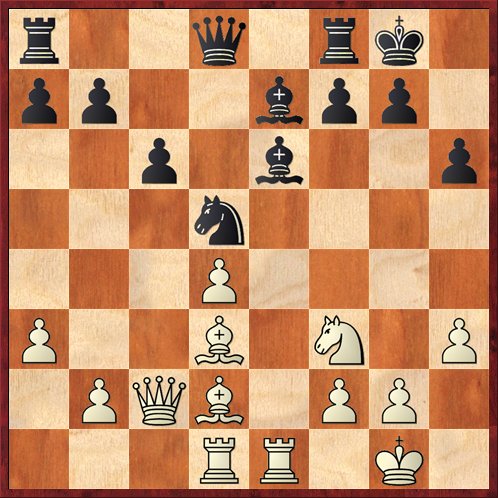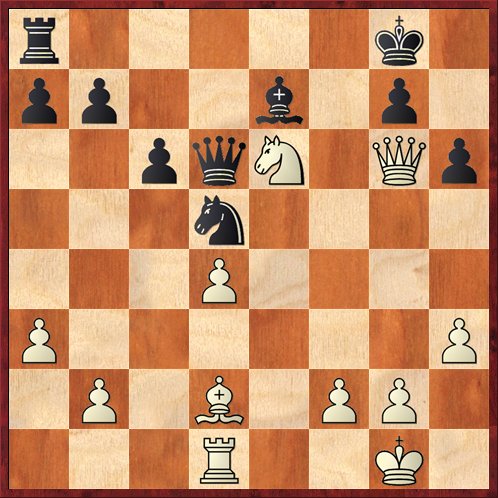Yesterday was a good news/bad news day for me at the US Open, but the bad left a deeper impression.
I won my morning game, a nice King’s Gambit (I was White) with Westerinen’s line 1. e4 e5 2. f4 ef 3. Bc4 Nf6 4. Nc3 c6 5. d4 Bb4. I lectured on that once for ChessLecture, so I think I was a little bit better prepared for it than my opponent. I’m pleased to say that I nearly upheld my pledge to make the first 10 moves in 20 minutes and the first 20 moves in 45 minutes. The actual figures I achieved were 10 in 23 and 20 in 57, and by that point I already had a won game.
In round 7, however, I had an epic fail. The one thing I had not done so far this tournament was play an outright blunder, but I did so in this game — walking into a highly unusual fork. As Black, I had a knight on g4 and a rook on b5, both undefended, and my opponent played 18. Qe2! and attacked them both! It was a classic example of the maxim “LPDO” (Loose Pieces Drop Off), which I also once lectured on for ChessLecture. If the truth be told, I was already in a difficult position before I made my howler; the blunder just made the game end 20 or 30 moves quicker.
So through 7 rounds, my score is 3-4, with all the games against players rated below me and quite a few of them substantially below. To put things into perspective, I am now in last place among all players rated 2100 or higher. (Not quite in last place among all experts, though; there is a 2000-rated player who has a score of 2.5-4.5.) The situation has gone beyond disappointing, beyond depressing, all the way to silly.
There’s one other person who is having as bad a week as I am: Tiger Woods. In the first three rounds of the Bridgestone Invitational golf tournament, a tournament he has won seven times, he has shot his worst three rounds ever at that golf course (72, 74, and 75) and he is now in 78th place out of 80 players. However, there is one thing I can be very glad of: when I screw up, nobody cares but me. When Tiger Woods screws up, everybody in the world finds out about it. Thank God I’m a nobody!
Cailen and Thadeus also have 3-4 scores. I just hope that none of us have to play each other this round.
One other Santa Cruz player is here, Dan Burkhard. We went out for dinner with him last night at an Oriental restaurant, and I ate Dan Dan Noodles in his honor! He is doing a little better than us, at 4-3. Also, Pablo Pena (an expert from the San Jose area) is having a great tournament, at 5-2, although he still has some work to do to win an expert prize. There are experts all the way up to 5.5 points.
As for the big boys, Alejandro Ramirez drew with Varuzhan Akobian in round 7 and leads with 6.5 points, and Alex Shabalov beat Larry Kaufman to tie him at that score. I would assume that Shabalov and Ramirez will be paired with each other in round 8, and I expect we will see a draw. That will give the large crowd of people at 6 points a chance to catch up. One of them is Daniel Naroditsky, whom I mentioned in my last post. Fellow blogger Mark Ginsburg is also at 6 points, as is Max Cornejo, whom Thadeus lost to in the first round.
Because it’s possible, in some far-fetched scenario, that Cornejo might actually take first place, let me show you the way that game ended. It’s a nice combination.
Black to move.
Here Thadeus said his plan was to play … Re8, … Bf8, and … Nf6 in some order, but he didn’t think the order mattered. Except, of course, the rook has to move before the bishop can, so he decided to play 1. … Re8 first. Big mistake! Can you see what White’s answer was? Here’s a hint: Black’s kingside is relatively undefended.
Cornejo played 2. Bh7+! (Full credit also for 2. Rxe6.) The next few moves were forced: 2. … Kh8 3. Rxe6! fe 4. Ne5. Now the threat is 5. Nf7+, which not only forks the king and queen but is also checkmate! (By the way, if you’re wondering why Black’s king didn’t move to f8 instead of h8, the answer is again 4. Ne5, threatening a nice twin checkmate on g6. Black can’t do anything except 4. … g5, and then 5. Qg6 leads to mate next move.)
Thadeus was forced to move his rook back to f8, and now Cornejo won a pawn with 4. … Rf8 5. Ng6+ Kxh7 6. Nxf8+ Kg8 7. Nxe6. At this point, Thadeus was a little bit shell-schocked and played 7. … Qd6 (I think 7. … Qe8 would have put up better resistance.) Then after 8. Qg6 Thadeus realized that he was going to lose another pawn, and he resigned.
Position after 8. Qg6.
At first I thought Thadeus had given up a little too soon, but he was right. After 8. … Bf6 white can play 9. Nxg7! and if, say, 9. … Ne7 then 10. Qxh6 finishes the liquidation of Black’s kingside. Alternatively, if 8. … Bf8 then simply 9. Bxh6 snags a second pawn. Thadeus can try 9. … Ne7 10. Qg4 Kf7, with a simultaneous threat on both of White’s minor pieces (LPDO!). But in this case, LPDO doesn’t hold because White can play 11. Nxf8 gh 12. Nd7, and the knight escapes unscathed.
By the way, if Thadeus had played 1. … Nf6 in the original position, defending h7, then White’s combination would not work, and Black would have a reasonable position.
Two more games left — one tonight, and one tomorrow afternoon. Will one of the young players, like Cornejo or Naroditsky, win the tournament? Will I manage to put a sugar coating on my debacle by winning my last two games? Stay tuned!




